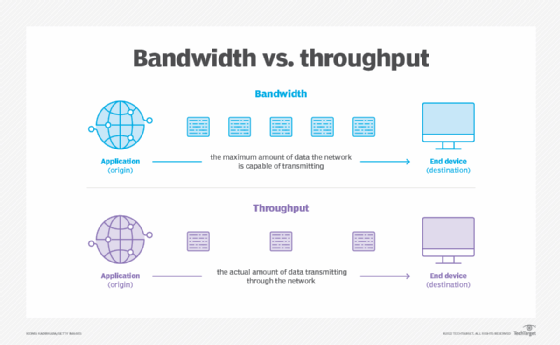
Getty Images/iStockphoto
Network bandwidth vs. throughput: What's the difference?
Bandwidth and throughput both indicate network performance. The terms are often used together, but bandwidth refers to capacity, while throughput details how much data actually transmits.
Bandwidth and throughput are two terms related to network performance. However, the relationship between bandwidth and throughput is like that of siblings rather than twins: They're similar but not the same.
Bandwidth and throughput both concern network data. Network bandwidth defines how much data can possibly travel in a network in a period of time. Network throughput refers to how much data actually transfers during a period of time. Bandwidth and throughput are also sometimes conflated with latency, which refers to the speed at which data travels across the network to its destination.
What is network bandwidth?
When thinking about bandwidth, the key word is capacity. Bandwidth refers to the maximum amount of data that could, theoretically, travel from one point in the network to another in a given time.
Bandwidth is a limited resource. Depending on their capacity, networks can handle only a certain amount of bandwidth, and some devices consume more bandwidth than others. Insufficient bandwidth can lead to network congestion, which slows connectivity. Network professionals can compensate for these factors by calculating the bandwidth requirements for devices and adjusting bandwidth allocation as needed.
Bandwidth measurement units include bit, kilobit, megabit (Mb) and gigabit (Gb). Say, for example, a network has a bandwidth of 1 Gb per second (Gbps). This means 1 Gb is the maximum amount of data that could travel between links in one second, in an ideal situation. Yet, most networks typically don't operate in ideal situations.
Networks sometimes experience slow connectivity, limited range, outages and other issues that diminish performance. In these situations, it takes longer for a data packet to travel across the network.

What is network throughput?
When thinking about throughput, the key word is amount. Throughput refers to the actual amount of data transmitted and processed throughout the network. If bandwidth describes the theoretical, throughput describes the empirical, and the numbers for each metric usually differ.
Because networks often experience issues that hinder performance, throughput often differs from the maximum network bandwidth. Throughput shows the data transfer rate and reflects how the network is actually performing. Unless the network operates at max performance, the throughput is lower than the bandwidth.
Throughput is measured with the same bitrate units as bandwidth. A network could have a bandwidth of 1 Gbps, which means it's capable of handling 1 Gbps. But, depending on the circumstances, its throughput could be only 500 Mbps, with the network processing half its capacity.
Where does latency fit with bandwidth and throughput?
Bandwidth and throughput are often used to describe network speed, but speed mostly depends on the latency of the network. Latency is a measurement of the amount of time it takes a data packet to travel from one point in the network to another, from sender to receiver.
Sometimes, latency is measured as round-trip time and includes the time it takes for a packet to travel from its destination point back to its origin point. If the latency is low, this indicates a delay, which is sometimes called lag.
Bandwidth and latency don't necessarily affect one another, but network professionals use the two metrics to analyze network performance. Latency issues are often more apparent in high-bandwidth networks. For example, if a network has 1 Gbps of bandwidth yet it takes two seconds for 1 Gb to travel between links, a network professional can determine an issue with low latency because the network performance is inadequate.
Throughput and latency, on the other hand, have an inversely proportional relationship. High-throughput networks have high amounts of data traveling between links, meaning the networks have low latency or little lag affecting the speed. Low-throughput networks have less data traveling and processing between links, meaning they may have high latency causing a delay in how long it takes data to reach its destination.
Why are network bandwidth and throughput important?
Bandwidth and throughput, as well as latency, are important metrics that network professionals use to monitor network performance. When network professionals measure bandwidth, they gain an understanding of the capabilities of their networks. Throughput serves as an indication of how well the network performs to that standard. Other metrics, such as latency, also indicate the network performance and can influence the network bandwidth and throughput numbers.








